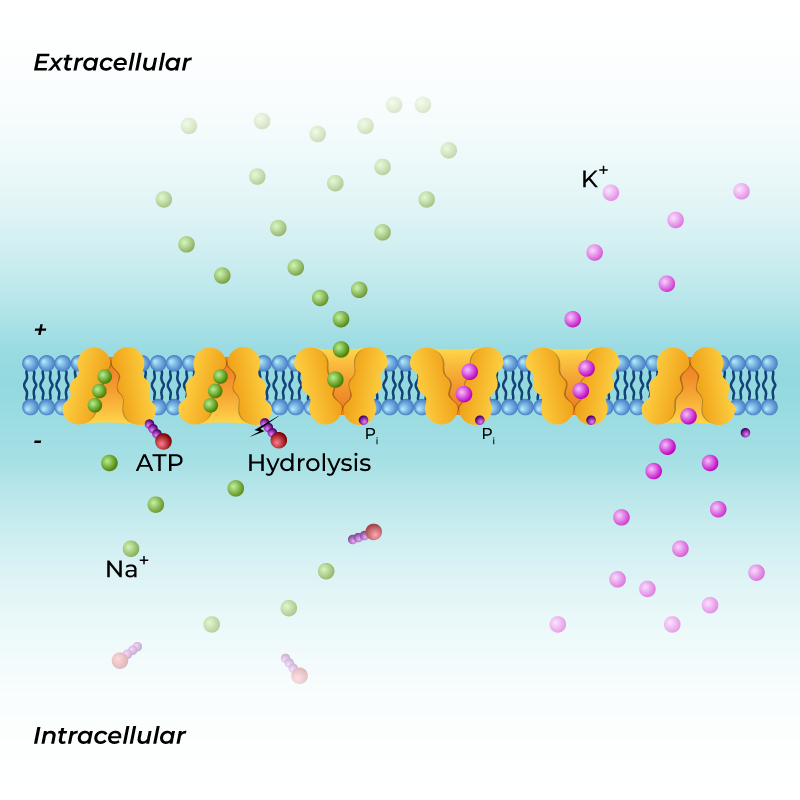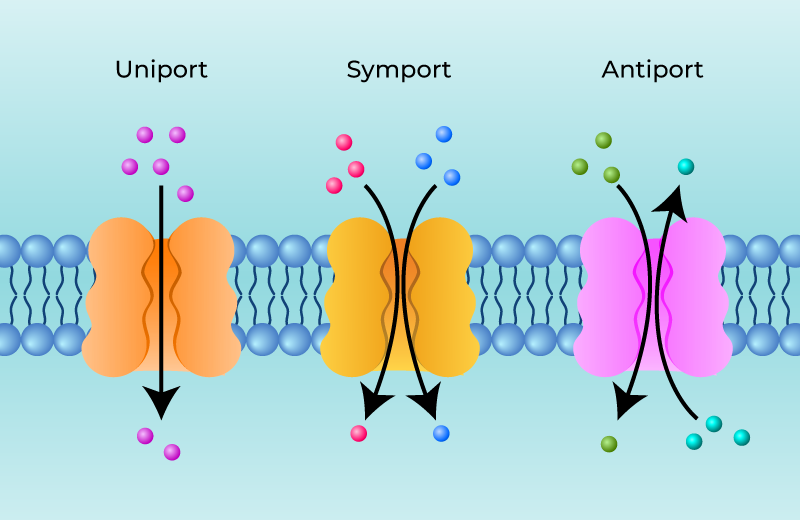Active Transport
Last Updated :
13 Jan, 2024
Active transport is a cellular process that uses energy mainly in the form of ATP, to move molecules or ions against their concentration gradients. It includes primary active transport, which directly uses energy for transport, and secondary active transport, which utilizes an electrochemical gradient to move other substances. It is essential for many physiological processes, including nutrient absorption in the digestive system, the transmission of nerve impulses, and the regulation of ion concentrations in cells.
Active Transport Definition
Active transport is a cellular process that uses energy to move molecules or ions from a region of lower concentration to a region of higher concentration against their concentration gradients across the cell membrane.
What is Active Transport?
Active transport is a biological process that transport molecules or ions from regions of lower concentration to regions of higher concentration across the cell membrane. Active transport requires cellular energy, usually in the form of adenosine triphosphate (ATP), to move molecules against the concentration gradient. In passive transport, molecules move with their concentration gradient.
Active transport is highly regulated and selective, with different transporters specific to different molecules or ions. This regulation occurs through various mechanisms like the number of transport proteins on the cell membrane, feedback mechanisms, and the availability of energy sources like ATP. Active transport is important for various physiological processes, such as hormone secretion, nutrient uptake, and nerve impulse transmission. Problem in active transport can lead to various disorders, including diabetes, cystic fibrosis, etc.
Also Read:

Types of Active Transport
There are two main types of active transport:
Primary Active Transport
Primary active transport, also called direct active transport, directly uses metabolic energy to move molecules across a membrane against their gradient. The most common example of this is the sodium-potassium pump (Na+/K+ pump), present in the cell membrane of most animal cells. The pump actively transports potassium ions into the cell and sodium ions out of the cell against their respective concentration gradients. This pump is crucial for maintaining the resting membrane potential and regulating the volume of individual cells. Different types of active transport are as follows:
- P-type ATPase: These are also referred to as E1-E2 ATPases because they have the ability to switch between two forms (E1 and E2). For example, they include the sodium-potassium pump (Na+/K+-ATPase), calcium pump (Ca2+-ATPase), proton-potassium pump (H+/K+ ATPase), and proton pump (H+ ATPase) found in plants and fungi.
- F-type ATPase: Alternatively known as ATP synthase or ATP phosphohydrolase (H+-transporter). Examples of this transport system include mitochondrial ATP synthase and chloroplast ATP synthase.
- V-type ATPase: These vacuolar proton-transporting ATPases are ATP-driven pumps located in the tonoplast of the cell. They harness the energy from ATP hydrolysis to transport protons across intracellular and plasma membranes of eukaryotic cells, resulting in many cell organelles having a more acidic environment than the surrounding cytoplasm. Mutational changes in this enzyme can lead to various consequences, such as cancer, neurodegenerative diseases, and aging. V-ATPases are complex multimeric proteins with two nearly separate domains, each with tissue-specific isoforms found in different organisms.
- ABC (ATP binding cassette) transporter: ABC transporters are a highly diverse class of carrier proteins that utilize energy derived from ATP hydrolysis to facilitate the movement of solutes across biological membranes
Secondary Active Transport
Secondary active transport, also known as cotransport, uses the energy created by primary active transport to transport other molecules against their concentration gradients. There are two subtypes of secondary active transport:

- Symport (cotransport): In symport, molecules move in the same direction as the ion that was pumped using primary active transport. For example, the sodium-glucose transporter (SGLT) is a symporter that uses the energy of the sodium gradient to move glucose into cells.
- Antiport (cotransport): In antiport, molecules move in the opposite direction of the ion pumped using primary active transport. An example is the sodium-calcium exchanger, which transports calcium out of the cell in exchange for sodium ions.
Active Transport in Plants
Active transport in plants help in the transport of materials, such as water, minerals, and necessary nutrients to all parts of the plant for its growth and development. Plant roots uses specialized proteins called carrier proteins, like the proton pump (H+-ATPase). It actively transports protons out of root cells,that creates an electrochemical gradient. It help in the uptake of minerals like calcium, potassium, and magnesium. It results in the accumulation of ions towards one side of the membrane and transports the substance from the lower concentration to higher concentration.
The process contributes to the plant’s ability to adapt to various environmental conditions through efficient nutrient absorption and internal distribution. Plant adaptations, such as root hairs and mycorrhizal associations, increases the efficiency of active transport. It enables the plants to thrive in a range of ecosystems.
Examples of Active Transport
Some examples of active transport processes are as follows:
- Sodium-Potassium Pump (Na+/K+ Pump): Found in animal cell membranes, it actively pumps sodium ions out of the cell and potassium ions into the cell, maintaining the cell’s resting membrane potential and regulating its volume.
- Calcium Pump (Ca2+-ATPase): This pump is responsible for actively transporting calcium ions out of the cytoplasm into the endoplasmic reticulum or extracellular space, playing a crucial role in muscle contraction and cell signaling.
- Hydrogen-Potassium Pump (H+/K+ ATPase): Found in the stomach lining, it actively pumps hydrogen ions into the stomach while moving potassium ions out, helping regulate gastric acidity for digestion.
- Proton Pump (H+ ATPase): Present in the plasma membrane of plant cells and various organelles, it actively transports protons (hydrogen ions) to maintain acidic conditions necessary for various cellular processes.
- Sodium-Glucose Transporters (SGLT): These transporters in the small intestine and kidney actively transport glucose against its concentration gradient by utilizing the energy stored in sodium ion gradients.
Differences between Active Transport and Passive Transport
|
Energy Requirement
|
Requires energy to move molecules against their concentration gradient.
|
Does not require energy; molecules move with their concentration gradient.
|
|
Movement of Molecules
|
Moves molecules from areas of lower concentration to areas of higher concentration.
|
Moves molecules from areas of higher concentration to areas of lower concentration.
|
|
Transport Proteins
|
Involves specific transport proteins, such as pumps and carriers, to facilitate movement.
|
May involve transport proteins, like channels and carriers, but can also occur directly through the lipid bilayer.
|
|
Saturation
|
Exhibits saturation kinetics, where the rate of transport may reach a maximum when transport proteins are fully occupied.
|
Follows linear kinetics, as transport is limited by the availability of transport proteins and the concentration gradient.
|
|
Direction of Movement
|
Can move molecules against their natural diffusion direction.
|
Moves molecules in the direction of their concentration gradient.
|
|
Role in the Cell
|
Essential for maintaining ion gradients, nutrient uptake, and various cellular processes.
|
Facilitates the passive movement of molecules like gases, water, and small polar compounds.
|
Also Read: Transport System in Plants Class 11 Biology
FAQs on Active Transport
1. What is Active Transport with Example?
Active transport is a cellular process that requires energy to move molecules or ions against their concentration gradients, as seen in the sodium-potassium pump (Na+/K+ pump) in cell membranes.
2. What are 3 Types of Active Transport?
The three types of active transport are:
- primary active transport,
- symport secondary active transport,
- antiport secondary active transport.
3. How is ATP used in Active Transport?
ATP is used in active transport that provides the energy to the transport protein that enable it to pump molecules or ions against their concentration gradients. This energy allows these proteins to actively transport substances, such as sodium and potassium ions, across cell membranes.
4. Why is Active Transport Important?
Active transport is essential for maintaining specific cellular conditions by regulating ion concentrations, enabling nutrient uptake, and facilitating various physiological processes, such as nerve impulse transmission. It ensures proper cell function and homeostasis.
5. What are the Uses of Active Transport?
Active transport is used to maintain vital ion gradients in nerve cells, facilitate nutrient absorption in the digestive system, regulate cell volume, and remove waste products and toxins from cells, ensuring proper cellular function and homeostasis.
Like Article
Suggest improvement
Share your thoughts in the comments
Please Login to comment...